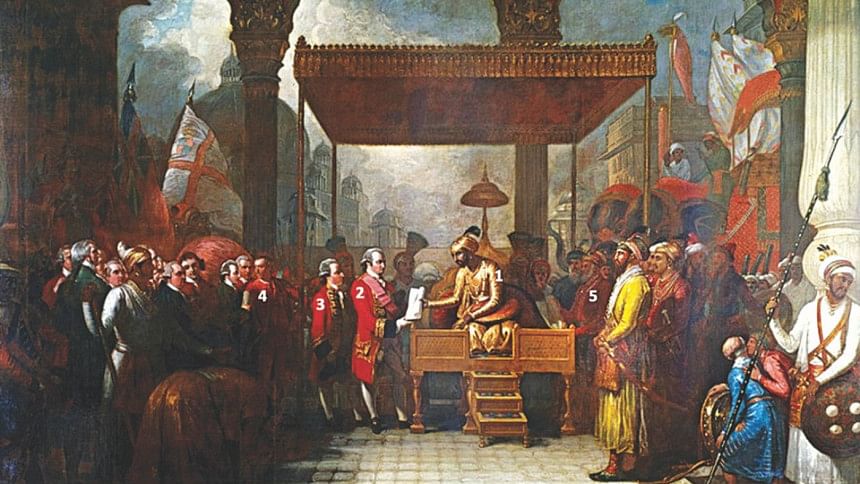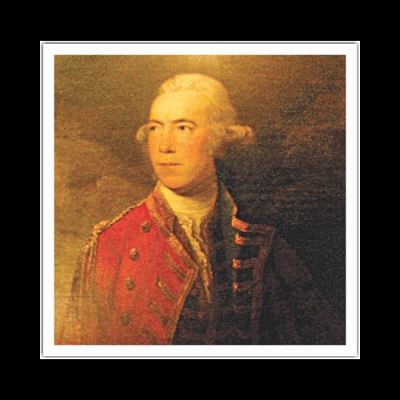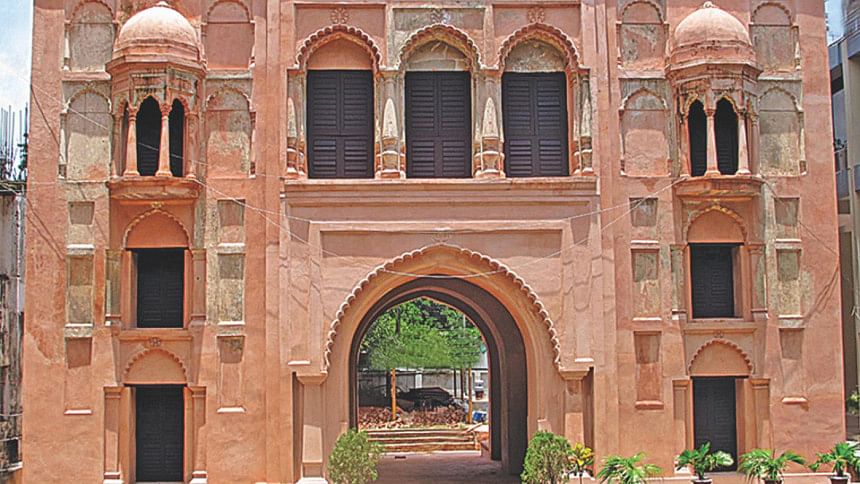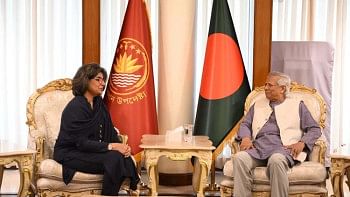SOOLTEEN SAHIB OF DHAKA

I came across the intriguing name of Swinton in the book, "Glimpses of Old Dacca", written by S.M. Taifoor. Swinton, the writer said had come to Dhaka, first in 1763 and then finally in 1765, to take over the administration, after the grant of the Diwani of Bengal by the effete Mughal Emperor Shah Alam II, to Robert Clive of the East India Company at Allahabad on 15 August, 1765. Swinton, the book further said, was also responsible for the building of the Nimtali Kothi or palace for the Naib Nazims of Dhaka. Symbolically, it was the most important secular edifice built by the Company in Bengal in 1765-66. For it signified the political demise of the Naib Nazims and heralded the supremacy and rule of the Company, especially, in the eyes of the citizenry of Dhaka.
Swinton on his return to Britain in 1766, writes Taifoor, had taken a certain Mirza Sheikh Itesamuddin of Nadia, Bengal, along with him. Itesamuddin was a learned Munshi and a courtier of the Mughal Emperor Shah Alam II. He was chosen as an emissary of the Mughal court and, if required, to act as the Persian scribe and interpreter. Swinton was to plead the Mughal Emperor's case to King George III of England. However, the mission came to naught due to the duplicity of Clive. It embarrassed Swinton and greatly disheartened Itesamuddin, who returned to Bengal in 1769. Subsequently, in the 1780s, Itesamuddin wrote in florid Persian, "Shigurf Nama-e-Vilayet" or "Wonderful Tales about Europe", a highly interesting account of his travels to France, England and Scotland. It was the first important travelogue on Europe written by an Indian at that time, albeit, in Persian.
In 2009, a resourceful contact in London put me in direct touch with the great-great-great grandson of Captain Archibald Swinton, a distinguished retired military officer, Major General Sir John Swinton (b.1925), KCVO, OBE, DL of Kimmerghame, Berwickshire, Scotland, who had commanded the Household Division and was also the General Officer Commanding (GOC) of London District from 1976-79. Sir John kindly put me in touch with his son James Swinton in Edinburgh. From the father and son, I gradually started to receive via electronic and surface mail a lot of rare information, both visual and in print, including a copy of the Journals of Archibald Swinton and, the remarkable history of the Swinton family. I had finally gathered enough resources to write a compelling story.

Archibald Swinton was born in 1731 in Scotland. Since ancient times, through the middle ages, right up to our contemporary times, the Swinton's a remarkable family of lowland Scots, originating from Scotland, have produced distinguished personalities in various fields of human endeavour with success. In particular, the family enjoys a long tradition of military service which continues to produce a breed of notable soldiers in the officer corps.
Swinton must be credited for meticulously maintaining his Indian journals, which he wrote in those turbulent times under trying circumstances. He kept a fairly detailed account of his sojourn, replete with important dates and historical events.
During the initial years of engagement with the Company in India, in various capacities, Swinton to his credit had mastered the Persian language so thoroughly that his services were in great demand at the highest echelon of the Company. An intelligent, perceptive and affable young man, he also took great interest in learning the customs, mores and manners of the Indian peoples, especially those of the elite, for which he was peculiarly gifted.

In the spring of 1763, Swinton was ordered by the Company's Provincial Council at Fort William, Calcutta, to proceed immediately to secure Dhaka, owing to a dispute between the Company and the new Nawab of Bengal Mir Qasim, whom the English had placed on the throne at Murshidabad. In Dhaka the English factory was threatened by the troops of the Nawab assisted by roaming bands of Fakirs and Sanyasis, but there being a considerable number of Sepoys it was defended. However, the Nawab's troops soon retreated and the English finding their ammunition running short and apprehending a second attack, thought it best to retire and regroup at Lakhsmipur, East of Noakhali, where the Company had an important, secure factory .This group from Dhaka was soon joined at Lakhsmipur by Captain Grant from Chittagong and Lieutenant Swinton from the East with a detachment of Sepoys. Amply reinforced they then returned to Dhaka and retook the factory and the possession of the city and districts, but by then parts of the city and the factory had been plundered by the Nawab's troops and looters. Swinton left Dhaka on August 4, 1763 for Murshidabad. He had stayed in Dhaka for about two months to settle things.
In 1763, Swinton, engaged in several important battles for the Company, mostly in Bihar (Udhuanala, Monghyr and Patna), was twice wounded, the last time so severely as to necessitate the loss of his right arm from above the elbow. Thus, his regular military career came to an end. However, because of his fluency in the Persian language and other attributes-acquired knowledge regarding the customs, mores and manners of the Indian elite and people, and for his varied experiences, he was greatly sought after by the Company for his advice and help in matters relating to the - civil, military and administrative as they arose in those volatile times.
The Battle of Plassey in 1757 saw the defeat of the ill-fated Nawab Nazim of Bengal, Bihar and Orissa, Siraj-ud-daulah by the forces of the East India Company under Colonel Robert Clive. But if Plassey was the "beginning of the end" of the Nawab of Bengal, then the end came "swiftly and decisively" at the Battle of Buxar, Bihar, in 1764, where the combined forces of the nominal

Mughal Emperor Shah Alam II, Nawab Nazim Mir Qasim of Bengal and that of the Nawab Vizier of Awadh (Oudh) Suja-ud-daulah were completely routed by the forces of the East India Company under Major Hector Munro. The Battle of Buxar was followed by the Treaty of Allahabad on 15 August, 1765 and the ceremonial handing over of the Diwani (in effect complete political control over the territory, revenue and administration) of Bengal, Bihar and Orissa to the East India Company. Thus, one of the richest provinces of the Mughal empire was granted to Robert Clive representing the East India Company by the Mughal Emperor Shah Alam II. This single ceremonial act had profound historical implications of global significance. It transformed the East India Company during its long years of unbridled, pervasive market monopoly in India (1765-1858), into the most successful forerunner of latter day multinational corporations. The possession of Bengal by the Company would eventually lead to the conquest of the rest of India and formation of the last great colonial empire in modern times - the British Raj (1858-1947) in India.

Immediately following the above mentioned changeover in 1765, the Provincial Council at Fort William in Calcutta, dispatched a capable officer Captain Archibald Swinton, fully conversant in Persian and in Indian customs and traditions to Dhaka again, to take over the local administration. Swinton skillfully curtailed the political authority of the Naib Nazim, Nawab Jusserat Khan, took over his old fort as his office-cum-residence, while 'respectfully' moving the Nawab, his family and court to the Bara Kuttra. Swinton was next ordered by the Company to build a permanent Palace-complex befitting the social prestige and status of the Naib Nazim, one of the premier nobles of Bengal. He proceeded earnestly to plan and build the Nimtali Kothi or Palace, but did not see its completion in 1766. He resigned from the services of the Company in October 1765 and, left India for good for his home in Scotland in the middle of January, 1766 as per his own journal.
During his brief stay in Dhaka in 1765, Swinton left a favorable impression. His language skills, amiable disposition and joviality endeared him to all. He did not behave like a conqueror, but used tact and diplomacy instead. Even long years after his departure from Dhaka, he was still fondly remembered as "Soolteen Sahib". The affairs in Dhaka was his last piece of important work in India. Swinton left India along with Itesamuddin under circumstances which he thus relates in his journals: "In the end of the year, 1765, the Emperor Shah Alam requested the English army to conduct him to Delhi, and assist in placing him on the Throne of his fore-fathers, but Lord Clive could not promise him that, he thus resolved with lord Clive's approbation to send a letter to the king of England to solicit his assistance."
The Mughal Emperor Shah Alam had naively hoped to forge an Anglo-Mughal alliance with King George III of England. However, a shrewd Clive had no such intention. It would have
jeopardised his own nefarious interests, that of the Company and its insatiably greedy, notoriously corrupt and profit mongering officials. Therefore, he cleverly suppressed the letter sent by the Mughal Emperor to the King of England. Thus, the mission of Swinton and Itesamuddin failed to materialise and a disillusioned Itesamuddin returned to Bengal, India, in 1769.
On his return to Scotland, Swinton bought Kimmerghame Estate in Berwickshire in 1771 and, married Henrietta Campbell in 1776. They had six children.
In 1804, during a tour Swinton suddenly died in Bath, England. He lies buried at the Abbey Church there.
(Condensed from a forthcoming book by the writer: Illustrated News & Tales)
The writer is the founder of Bangladesh Forum for Heritage Studies

 For all latest news, follow The Daily Star's Google News channel.
For all latest news, follow The Daily Star's Google News channel. 



Comments